

Deforming ground in impact and fracture. I did something similar for a Nike commercial a while back: at 00:46 when the wrecking ball impacts the wall.

You can do that with a cloth deformation, most likely that will give you 60-70% of the motion and shape that you want. So you can blend shape it with the original -- you can define a radial falloff in color and mix inside a vopsop to get closer to the precise impact shape that you want. It's kinda like this: *) create a medium resolution grid, perform the cloth sim on this. . *) blend your cloth sim with the original geometry based on a custom mask (1) *) create your wall & prefracture it. *) create centroid points for your pieces. *) check if you can copy your pieces back onto your centroids *) deform your centroid points with your cloth sim from (1) *) copy your pieces onto your moving centroid points. (2) Make sure to modify your orientation based on a Normal and Up vector (or build your orient quaternion if you prefer). -- done.... for basic setup Have fun.
POP slide/creep? H13. Solver Sop inside Sop Solver! Animated packed primitives in H13 Bullet. Hi -- I'm trying to figure out a way to get animated/deforming geometry working for packed primitives in dops.
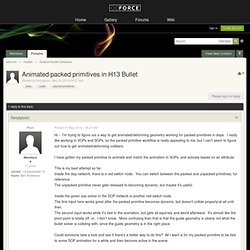
I really like working in VOPs and SOPs, so the packed primitive workflow is really appealing to me, but I can't seem to figure out how to get animated/deforming colliders. I have gotten my packed primitive to animate and match the animation in SOPs, and activate based on an attribute This is my best attempt so far. Inside the dop network, there is a red switch node. You can switch between the packed and unpacked primitives, for reference. The unpacked primitive never gets released to becoming dynamic, but maybe it's useful. Inside the green sop solver in the DOP network is another red switch node. The first input here works great after the packed primitive becomes dynamic, but doesn't collide properly/at all until then.
The second input works while it's tied to the animation, but gets all squirrely and weird afterward. Orange Animation. Procedural venation - Modeling. 'kleer001', on 20 Nov 2013 - 7:40 PM, said: I thought I was clever, but I guess not so much.

Can anyone else make heads or tails of this procedure? Totally understand that the creator wants to keep his work private, and the clues look straight forward enough. How to use impact data of RBD objects. Random subdivision and distance based subdivision. - Modeling. Hi All,I'm trying to do 2 things but I think they are about the same.1) trying to subdivide or better copy a bunch of cubes to form the following pattern: I would like then to turn it into a glue rdb afterward.But first I need to get to this..I tried to follow 2 different tutorials, Peter Quin discovery title sequence and SideFX own lego type boxelizer.But I think I need to get an hybrid between the 2.I think that my problem is that I need to group each copy and use it as new boundary or something like that. 2) Based on the same idea, I would like to try to get the cube to be divided like this (here is a sliced view).

And again I would like to turn it into an rdb object later on. The Nature of Code. “I am two with nature.” — Woody Allen Here we are: the beginning.
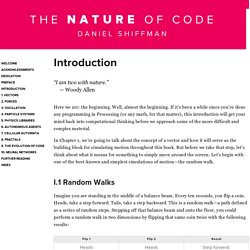
Well, almost the beginning. If it’s been a while since you’ve done any programming in Processing (or any math, for that matter), this introduction will get your mind back into computational thinking before we approach some of the more difficult and complex material. In Chapter 1, we’re going to talk about the concept of a vector and how it will serve as the building block for simulating motion throughout this book.
But before we take that step, let’s think about what it means for something to simply move around the screen. How to use impact data of RBD objects. Particle instance. FE Wood splinters workflow. Animating a rbd object. Elastic effect on flip fluids on H12. That setup looks good for strain.
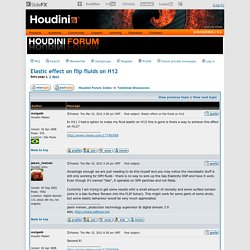
The only big thing missing is the strain isn't being rotated by the velocity field. So if you have a blob that is stretched in X, then rotated 90 degrees, it will still try to restore along the X axis. Gas Velocity Stretch is supposed to fix this, but it is a pretty subtle thing. Eetu's lab - Work in Progress. Elastic effect on flip fluids on H12. That setup looks good for strain.
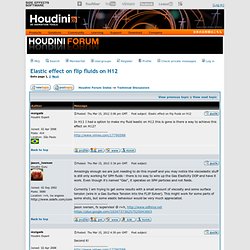
The only big thing missing is the strain isn't being rotated by the velocity field. So if you have a blob that is stretched in X, then rotated 90 degrees, it will still try to restore along the X axis. Houdini12 Flip Customize Resize. Zero Gravity Fluids. Hello All, Im trying to create some microgravity fluid sims within Houdini and have been running into a few issues.
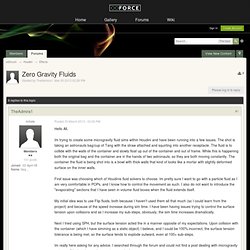
The shot is taking an astronauts bag/cup of Tang with the straw attached and squirting into another receptacle. The fluid is to collide with the walls of the container and slowly float up out of the container and out of frame. While this is happening both the original bag and the container are in the hands of two astronauts, so they are both moving constantly. The container the fluid is being shot into is a bowl with thick walls that kind of looks like a mortar with slightly deformed surface on the inner walls. First issue was choosing which of Houdinis fluid solvers to choose. Masterclass: Crumpling and Tearing. Masterclass: Crumpling and TearingPublished: July 2, 2009 for Houdini 10 Presented by Martin Sawtell, this Masterclass covers the new crumpling and tearing features that are available in Houdini 10's physically-based cloth solver.

These include support for plastic deformation, dynamic tearing and changing topologies. The presentation includes direction on basic workflows, and fundamental physical properties of cloth objects. Many of these concepts are supported by working example files including smashing cars, cutting fabric and collapsing buildings. Video Bit Torrent - [289 MB] Download Scene Files - crumpling.zip [94MB] Watch Presentation: Crumpling and Tearing - [289MB QT - 90 Mins.] Multiple Cloth piecs with one Cloth DOP. FLIP fluids and curve field. Perfect thanks a lot, both works well.
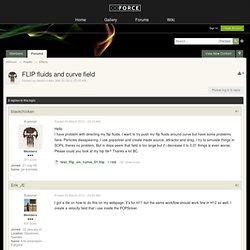
Im little bit comfused from VOPpop as volumetric field but need some time to understend. Thanks a lot Eetu, works great too. i have some qausetions which I discover with FLIP fluids 1, If I change particle separation for final resolution, all fields has different impact on liquid, they are, much stronger. Creating simple tornado motion using pointcloud. So interesting...both setups! Bunker, I was checking your scene and the visualization coming from the DOP network is really cool even in OpenGL!! So I tried to cache this somehow, but when I used an DOP I/O I realized I needed to multiply the density 10 times (I used a Volume Mix for this, not sure if there´s a faster way...this one works) to match your visualization parameters in the smoke dobject. My question being....in order to render a scene like this, would you just cache that and throw in a volume shader?
I´m bettin it can´t be that difficult to get it looking nice, considering how good it looks in Open GL already! EDIT: Yup. Deforming RBDs. Simple setup that uses a SOP solver and deforms the geo at points of impact. The impact data is already available in the SOP solver, the normal is the impact direction and there is a pscale attribute for the magnitude of the impact. In this setup I just used attributeTransfer to get the impact data onto the mesh, then a vopsop to deform the mesh. Particles and debri geo. Pin Constraint Points Selection. Snow creating. How to activate simulation on parts of geometry in controllable manner. Hi, I made it to work. In sops, look for the way I created the groups in the copy sop, instead of using more operators.
Bullet or RBD for fracturing/crumbling effects? Hey Peter, wow, annother great post that gets my head spinning! 1) A/B and 4)- lowres geo -> sim -> position data to highres geoI get the overall idea of what you say - interesting and convinient approach!